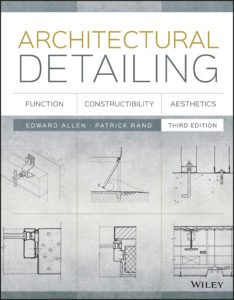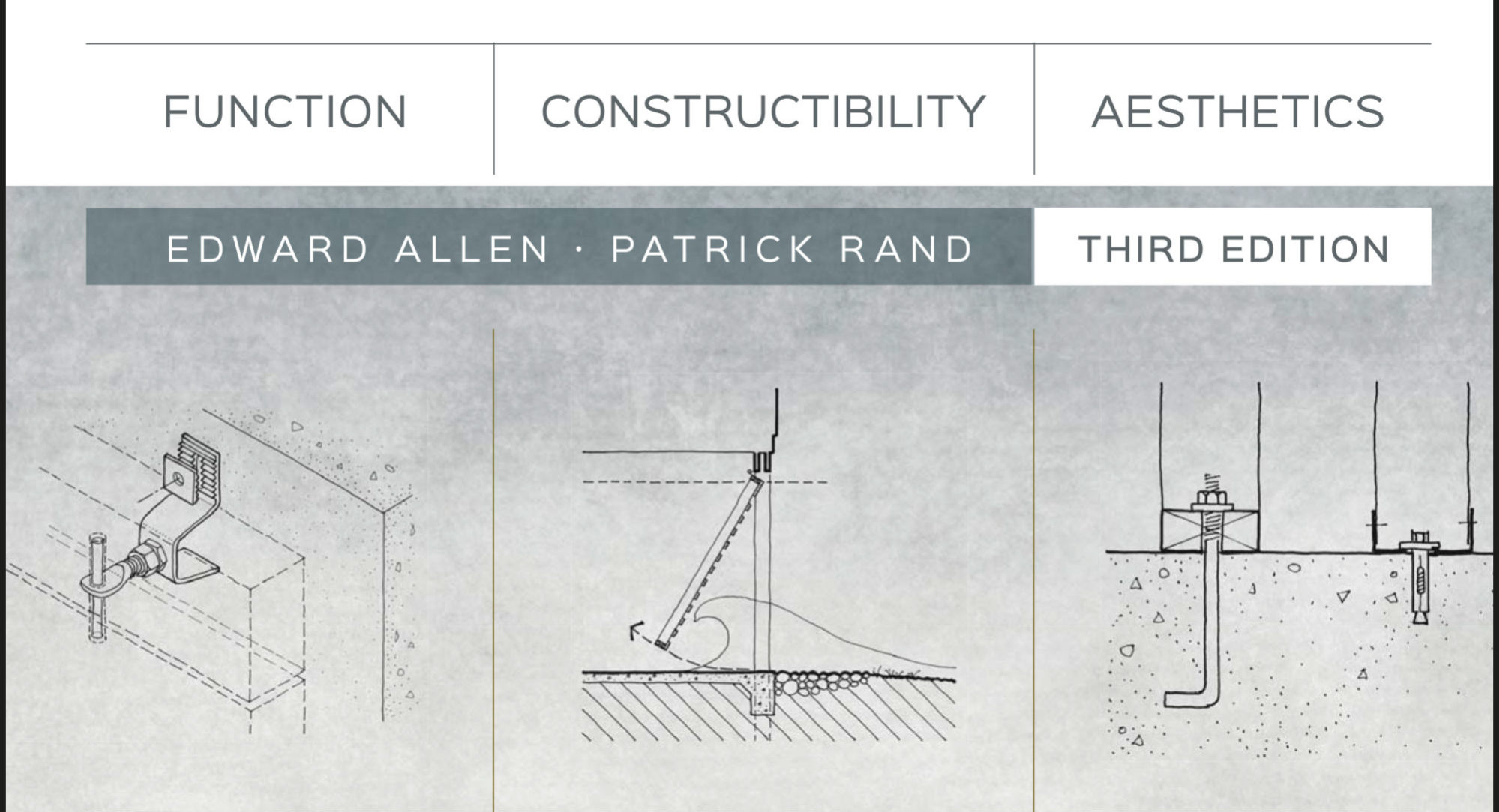
Architectural Detailing
Edward Allen and Patrick Rand
Wiley Publishing
Architectural Detailing
Review by Thomas DeVoss
Architectural Detailing provides an introduction to the basics of drawing details (the places where materials intersect) for standard construction. While it may not have as many diagrams as Ching’s Building Construction Illustrated, or have the depth of Architectural Graphic Standards, it does an especially good job of explaining the purpose of each construction component.
Instead of presenting a complex detail with little or no context for what each building element may do, this book presents its drawings alongside clear descriptions of the function of each individual element. This book would be valuable for anyone who wants to learn how and why things are built, rather than just copying a random detail from a Google image search.
Written by Edward Allen, FAIA a former faculty member at Yale and MIT, and Patrick Rand, FAIA Distinguished Professor of Architecture at North Carolina State University, Architectural Detailing is organized into two parts. Part one examines building necessities like controlling heat, water, sound, air, weather, age, and movement. Also considered is how to detail for “ease of assembly”, “efficient use of construction resources”, and “aesthetics.” Part two compares wood, concrete, and brick-faced details. The diagrams are easy to read and understand throughout.
Even as a licensed architect working in the profession for almost 20 years I found some parts to be particularly insightful. The section discussing “Accessible Connections” shows why the architect should consider the construction process when drawing details so that the builder can access all the connections in the correct order. Here the authors include two diagrams; one that shows a logical detail, and one that shows a detail that would make construction much more difficult for the contractor. Showing the “good” and “awkward” details next to each other is helpful in explaining why detailed planning and craftsmanship work.
Another important chapter is “Key details to develop.” The diagrams in this chapter highlight the specific parts of a plan and section that an architect should focus on, per building type.
A chapter that would have helped me design more realistic buildings when I was in Architecture school is “Providing Passages for Mechanical and Electrical Spaces.” Many times while reading this book I thought how helpful this would have been earlier in my professional career.
This book does not contain the detail for every single situation, but I do believe that someone – using the concepts and diagrams in this book – would understand how to draw all the details necessary to describe a standard building for construction, whether it be made of wood, concrete, or brick.
This book is written for aspiring architects but a non architect would be interested to learn how much architects have to consider that often goes unnoticed. Anyone can visit a Herzog and de Meuron or Renzo Piano-designed museum and appreciate that the glass meets the floor in a sleek and novel way, but this book can help you understand the principles they have considered, mastered, and tweaked to achieve their effect.
This book reminds me that detailing is an art. High-quality detailing can be the difference between a great building and a terrible one, both functionally and aesthetically. It can be the difference between the Sendai Mediatheque gracefully surviving a massive earthquake and a carelessly designed apartment building catastrophically pancaking.
Sloppy details can lead to water damage, rooms that are too hot or cold, and a host of other performance problems that can effect occupant health and safety, building durability, and maintenance cost.
Beauty really is in the details, and if you’re interested in learning how to recognize and develop them, I would recommend this book.
Los Angeles architect Thomas DeVoss, AIA, LEED provides design services for a variety of civic, cultural, and residential projects, including an off-grid orphanage complex in Haiti and sustainable master plans in Australia. As a member of the Art Director’s Guild (Local 800), he also supplies set sketches, 3d models, set design, and renders to the commercial entertainment industry.


